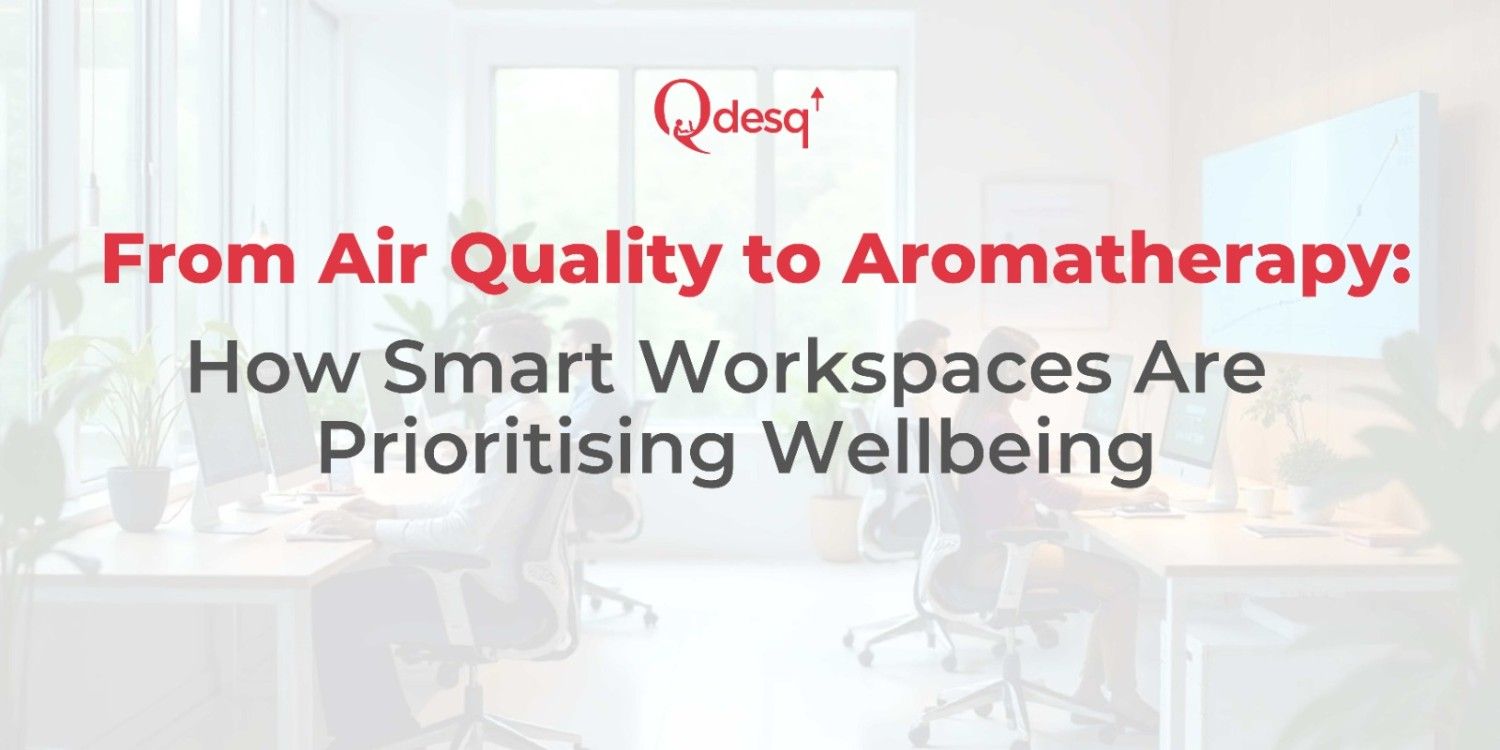What is Indoor Air Quality (IAQ)?
Numerous studies indicate that we spend as much as 90% of our time indoors, whether at home, school, work or during leisure activities. As buildings become more energy-efficient by containing air, the significance of indoor air quality in offices (IAQ) is growing, alongside our understanding of its impact on the health and well-being of occupants.
IAQ refers to the air quality within buildings and is affected by several factors, including pollutants, temperature, humidity, and ventilation. Poor indoor air quality can lead to adverse health effects such as respiratory issues, allergies, and cardiovascular problems.
Heating, ventilation, and air conditioning (HVAC) systems ensure healthy indoor environments. Maintaining good indoor air quality starts with identifying and reducing sources of pollution, whether through filtration systems, purification methods, or simply cutting contaminants at the source. Just as crucial are proper ventilation and keeping temperature and humidity in check. Paying attention to these factors isn’t just about comfort; it’s about creating healthier, more livable spaces at home and in the workplace.
The Importance of Clean Air in the Workplace
Clean air in the workplace isn’t just nice-to-have; it’s a necessity. From keeping people healthy to helping them stay sharp and productive, indoor air quality plays a bigger role than most realise. Here’s a closer look at why it matters more than you might think:
1. Healthier Employees, Fewer Sick Days
Polluted indoor air can trigger respiratory issues, allergies, headaches, and fatigue. These symptoms often worsen in poorly ventilated spaces, clinically termed “sick building syndrome”, and tend to improve once people leave such environments. By contrast, cleaner air reduces these health risks, helping employees stay well and reducing absenteeism.
2. Enhanced Cognitive Function & Productivity
Studies (including research from Harvard) show that workers in offices with cleaner air perform significantly better, by as much as 61%, on cognitive tasks compared to those in standard environments. Lower CO₂ and particulate pollution levels also help sharpen focus, improve decision-making, and allow for sustained attention.
3. Improved Comfort, Morale & Well‑being
Fresh, clean air creates a more comfortable atmosphere, boosting mood and reducing stress when employees feel cared for; satisfaction, motivation, and retention all rise. Clean air also reduces unpleasant odours and stuffiness, providing a positive experience for staff or customers.
4. Stronger Business Outcomes
Healthier, happier employees translate into better performance and profitability. Upgrading air quality – whether through better HVAC systems or placing purifiers in busy areas – can pay off in fundamental ways: fewer sick days, sharper productivity, and even happier customers.
Best Practices for Clean Workspace Air
To boost workplace air quality, organisations should:
- Ensure adequate ventilation, bringing in fresh air and reducing CO₂ buildup
- Use filtration systems, such as HEPA filters and activated carbon units, to remove particulates and VOCs
- Conduct regular HVAC maintenance, including timely filter replacement and humidity control
- Monitor CO₂ levels as an indicator, keeping them well below thresholds linked to cognitive decline
- Implement supplemental solutions, like portable purifiers or scheduled natural ventilation (e.g., opening windows)
Clean air is the unsung hero of a thriving workplace. Its impact stretches beyond just comfort – fewer sick days, sharper thinking, better moods, and even stronger business results all tie back to the quality of the air people breathe daily. Organisations prioritising air quality will see healthier employees, sharper focus, and stronger results.
Advancements in Smart Air Purification Technology in Workspaces
In today’s era of innovative wellness workspaces, cutting-edge air purification technologies are transforming how we maintain clean, healthy indoor environments. Here’s a look at the latest breakthroughs:
- Hybrid Filtration: Combine HEPA, carbon, UV light, ionisers, and oxidation to tackle dust, gases, microbes, and allergens simultaneously.
- Smart Monitoring with AI: Sensors and AI adjust settings in real-time and even predict pollution spikes to clean the air before issues arise.
- Hands-Free Control: Works with Alexa, Google Assistant, and smart home apps for voice commands, scheduling, and geofenced automation.
- Filter Smarts: Tracks filter life and sends timely alerts, cutting waste and keeping performance high without the guesswork.
- Next-Gen Purification: Techs like plasma ionisation and self-cleaning graphene filters boost efficiency and reduce upkeep.
- Eco-Friendly Design: Built for sustainability with low-energy motors, long-lasting filters, and recyclable parts.
Why It Matters for Smart Wellness Workspaces
Combining sensor-driven precision, seamless connectivity, and proactive maintenance, these advanced purification systems support healthier, more focused, and more comfortable indoor environments. They represent a shift in workplace design: clean air is now an intelligent, responsive service, key to elevating well-being and productivity in modern “smart wellness workspaces.”
Integrating Smart Air Purification into Office Spaces
1. Begin with a Comprehensive IAQ Assessment
Start by conducting a thorough indoor air quality (IAQ) audit, assessing key factors like PM₂.₅ levels, volatile organic compounds (VOCs), carbon dioxide, humidity, and other airborne pollutants. With this data, you’ll be better equipped to choose the right purification solution tailored to each workspace’s unique needs.
2. Strategically Deploy Smart Purifiers
- Portable units equipped with HEPA and activated carbon filters can target localised pollution at breathing zones.
- Integrated systems, installed within HVAC units and controlled by Building Management Systems (BMS), provide building-wide purification.
For example, Blueair’s HealthProtect line is IoT-enabled for real-time monitoring and control across residential and professional offices.
3. Use IoT for Real‑Time Monitoring and Control
Smart purifiers are now equipped with sensors for PM₂.₅, CO₂, VOCs, humidity, and more. They connect via Wi‑Fi or wired systems to provide instant air-quality feedback. The collected data can be stored, visualised, and analysed through intuitive dashboards, making it easy to manage air quality remotely. It also supports innovative features like automated purification schedules and voice control through platforms like Alexa, Google Assistant, etc.
4. Implement AI‑Driven Predictive Maintenance
- Integration with AI and machine learning shifts air purification from reactive to proactive.
- Predictive scheduling adjusts purification levels before air quality dips.
- Maintenance alerts are generated based on actual filter usage, avoiding unnecessary replacements.
- Energy optimisation dynamically adjusts fan speeds and ventilation based on occupancy patterns and pollutant levels.
5. Integrate with HVAC/BMS for Optimal Efficiency
Smart units should work in harmony with central systems:
- HVAC intake can be reduced when purified air is recirculated.
- Ventilation rates can automatically adjust based on occupancy and IAQ sensor data for energy savings.
Modern innovative HVAC systems use sensors, central dashboards, and AI to optimise ventilation, filtration, pathogen control, and moisture, elevating air quality to rival outdoor standards.
6. Business Benefits
- Health and Attendance: Cleaner air reduces respiratory issues and sick days.
- Productivity and Well‑Being: Better air enhances concentration, comfort, and morale.
- Energy and Cost Efficiency: Predictive systems lower utility bills and streamline maintenance.
- Sustainability and Compliance: Supports LEED, WELL, and RESET certification standards.
7. Best Practice Checklist
- Perform IAQ audits and map pollutant zones.
- Mix portable and integrated purification systems.
- Deploy IoT sensors across critical zones.
- Activate AI tools for predictive control.
- Integrate systems with HVAC and BMS.
- Monitor performance and adjust strategies over time.
Workspace examples
| Client/Company | Deployment Strategy | Results Highlights |
|---|---|---|
| Ford India | 14 portable Blast units in office space | –95% PM₂.₅, ‑68% VOCs |
| Zomato, Gurgaon | HVAC filters + portable purifiers + sensors | –87% PM₂.₅, –82% formaldehyde, –93% VOCs |
| Microsoft Noida | 35 IAQ monitors + HVAC/BMS integration | Real-time management of CO₂, TVOCs, PM |
| Blueair (global) | AWS-connected HealthProtect units | Global updates, filter tracking, IoT scalability |
The Benefits of a Tech-Savvy Air Purification Approach
- Relief from Asthma Symptoms: Air purifiers with HEPA filters remove dust, pollen, and other asthma triggers, easing symptoms like coughing and wheezing by improving indoor air quality.
- Enhanced Respiratory Health: By removing indoor pollutants, air purifiers help prevent throat irritation, coughing, and long-term respiratory issues, even in healthy individuals.
- Helps with Allergens and Pet Dander: They capture dust, mould spores, smoke, and pet dander, common allergens that trigger asthma and allergic reactions.
- Neutralises Unpleasant Odours: Activated carbon filters in purifiers trap odours from cooking, pets, and smoke, keeping indoor spaces smelling clean.
- Reduces Harmful Chemicals: Air purifiers filter out indoor toxins from cleaners, appliances, and outdoor pollution, improving air quality, especially in high-traffic or industrial areas.
- Reduces the Chances of Airborne Diseases: HEPA filters trap bacteria and viruses, lowering the risk of airborne illnesses, especially in shared or poorly ventilated spaces.
Final Words
Workplace well-being is no longer just about comfy chairs or standing desks. Clean indoor air, often overlooked, is becoming a key factor in employee health and performance. Investing in smart air purification isn’t a fad; it’s a strategic move. Companies prioritising air quality will protect their teams and strengthen productivity, trust, and long-term success. Simply put, clean air is essential.











